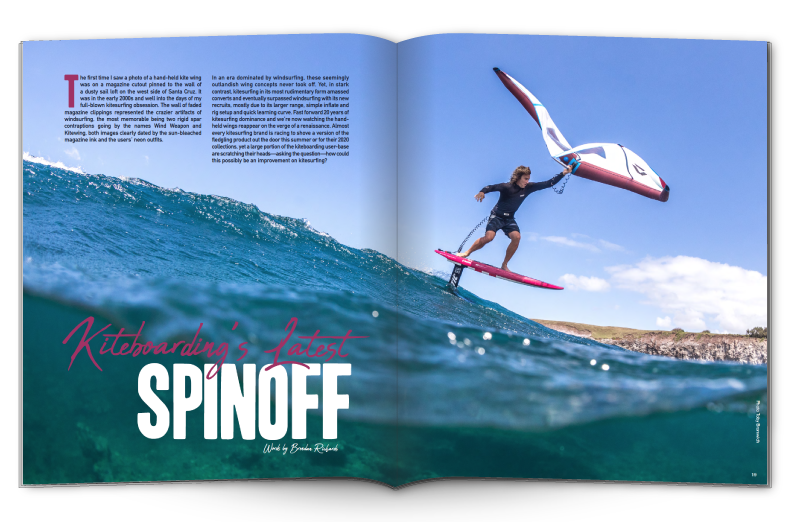The first time I saw a photo of a hand-held kite wing was on a magazine cutout pinned to the wall of a dusty sail loft on the west side of Santa Cruz. It was in the early 2000s and well into the days of my full-blown kitesurfing obsession. The wall of faded magazine clippings represented the crazier artifacts of windsurfing, the most memorable being two rigid spar contraptions going by the names Wind Weapon and Kitewing, both images clearly dated by the sun-bleached magazine ink and the users’ neon outfits.
In an era dominated by windsurfing, these seemingly outlandish wing concepts never took off. Yet, in stark contrast, kitesurfing in its most rudimentary form amassed converts and eventually surpassed windsurfing with its new recruits, mostly due to its larger range, simple inflate and rig setup and quick learning curve. Fast forward 20 years of kitesurfing dominance and we’re now watching the handheld wings reappear on the verge of a renaissance. Almost every kitesurfing brand is racing to shove a version of the fledgling product out the door this summer or for their 2020 collections, yet a large portion of the kiteboarding user-base are scratching their heads””asking the question””how could this possibly be an improvement on kitesurfing?

If windsurfing is a sail that is fastened to the board and a kite is a sail that uses lines and a control bar to fly a canopy remotely in the sky, then the hand-held kite wing is a hybrid apparatus occupying the space somewhere in between. It’s free-floating and detached from the board like a kite, but it’s controlled by the user’s hands on a boom, much like windsurfing. Of course, the first versions of hand-held wings probably go back to early human attempts at aviation, but the most immediate ancestor was developed by Tom Magruder in the Columbia River Gorge in the mid-1980s. Called the Wind Weapon, it was a dihedral wing constructed of windsurfing materials with a long, vertical pole that attached the wing to a windsurfing board. It was a niche product that looked like windsurfing until you jumped in the air and hung from the symmetrical wing. When you look at the early footage, the awkward handling and technical skills did not outweigh the big air performance that pro-caliber windsurfers could already obtain with conventional rigs. The other early hand-held device was the Kitewing which used a completely hand-held windsurfing spar-based construction and found its application in skiing, mountainboarding and ice skating. While both were niche wing products, neither the Wind Weapon nor the Kitewing ever found mainstream acceptance outside of small groups… To read the full article become a subscriber of Tkb Magazine.


